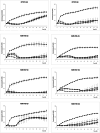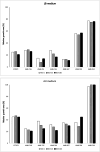Characterization of bacteriophages infecting multidrug-resistant uropathogenic Escherichia coli strains
- PMID: 38851653
- PMCID: PMC11162368
- DOI: 10.1007/s00705-024-06063-x
Characterization of bacteriophages infecting multidrug-resistant uropathogenic Escherichia coli strains
Abstract
Uropathogenic Escherichia coli (UPEC) is the most common causative agent of urinary tract infections, and strains that are resistant to antibiotics are a major problem in treating these infections. Phage therapy is a promising alternative approach that can be used to treat infections caused by polyresistant bacterial strains. In the present study, 16 bacteriophages isolated from sewage and surface water were investigated. Phage host specificity was tested on a collection of 77 UPEC strains. The phages infected 2-44 strains, and 80% of the strains were infected by at least one phage. The susceptible E. coli strains belonged predominantly to the B2 phylogenetic group, including strains of two clones, CC131 and CC73, that have a worldwide distribution. All of the phages belonged to class Caudoviricetes and were identified as members of the families Straboviridae, Autographiviridae, and Drexlerviridae and the genera Kagunavirus, Justusliebigvirus, and Murrayvirus. A phage cocktail composed of six phages - four members of the family Straboviridae and two members of the family Autographiviridae - was prepared, and its antibacterial activity was tested in liquid medium. Complete suppression of bacterial growth was observed after 5-22 hours of cultivation, followed by partial regrowth. At 24 hours postinfection, the cocktail suppressed bacterial growth to 43-92% of control values. Similar results were obtained when testing the activity of the phage cocktail in LB and in artificial urine medium. The results indicate that our phage cocktail has potential to inhibit bacterial growth during infection, and they will therefore be preserved in the national phage bank, serving as valuable resources for therapeutic applications.
Keywords: Escherichia coli; UPEC; UTI; bacteriophages; phage therapy.
© 2024. The Author(s).
Conflict of interest statement
The authors declare no conflict of interest.
Figures





Similar articles
-
Characterization of Anti-Bacterial Effect of the Two New Phages against Uropathogenic Escherichia coli.Viruses. 2021 Jul 12;13(7):1348. doi: 10.3390/v13071348. Viruses. 2021. PMID: 34372554 Free PMC article.
-
Isolation and Characterization of Novel Lytic Phages Infecting Multidrug-Resistant Escherichia coli.Microbiol Spectr. 2022 Feb 23;10(1):e0167821. doi: 10.1128/spectrum.01678-21. Epub 2022 Feb 16. Microbiol Spectr. 2022. PMID: 35171030 Free PMC article.
-
Rapid formulation of a genetically diverse phage cocktail targeting uropathogenic Escherichia coli infections using the UTI89 model.Sci Rep. 2025 Apr 14;15(1):12832. doi: 10.1038/s41598-025-96561-y. Sci Rep. 2025. PMID: 40229393 Free PMC article.
-
Bacteriophage therapy for inhibition of multi drug-resistant uropathogenic bacteria: a narrative review.Ann Clin Microbiol Antimicrob. 2021 Apr 26;20(1):30. doi: 10.1186/s12941-021-00433-y. Ann Clin Microbiol Antimicrob. 2021. PMID: 33902597 Free PMC article. Review.
-
Managing urinary tract infections through phage therapy: a novel approach.Folia Microbiol (Praha). 2020 Apr;65(2):217-231. doi: 10.1007/s12223-019-00750-y. Epub 2019 Sep 7. Folia Microbiol (Praha). 2020. PMID: 31494814 Review.
Cited by
-
Physicochemical, genomic, and phenotypic characterization of Escherichia phage BME3.Microbiol Spectr. 2025 Jul;13(7):e0130124. doi: 10.1128/spectrum.01301-24. Epub 2025 May 22. Microbiol Spectr. 2025. PMID: 40401929 Free PMC article.
-
Biological characterization of novel Escherichia coli O157:H7 phages and their bacteriostatic effects in milk and pork.Front Microbiol. 2025 Feb 6;16:1516223. doi: 10.3389/fmicb.2025.1516223. eCollection 2025. Front Microbiol. 2025. PMID: 39980686 Free PMC article.
-
Isolation, Characterization, and Unlocking the Potential of Mimir124 Phage for Personalized Treatment of Difficult, Multidrug-Resistant Uropathogenic E. coli Strain.Int J Mol Sci. 2024 Nov 27;25(23):12755. doi: 10.3390/ijms252312755. Int J Mol Sci. 2024. PMID: 39684465 Free PMC article.
-
Phage Endolysins as Promising and Effective Candidates for Use Against Uropathogenic Escherichia coli.Viruses. 2025 Apr 13;17(4):560. doi: 10.3390/v17040560. Viruses. 2025. PMID: 40285003 Free PMC article. Review.
References
MeSH terms
Substances
Grants and funding
LinkOut - more resources
Full Text Sources

